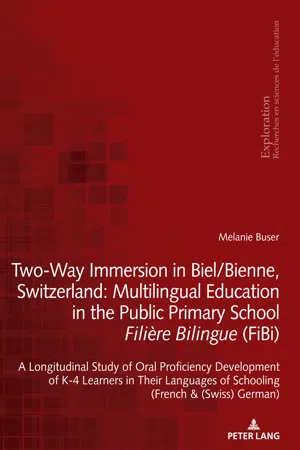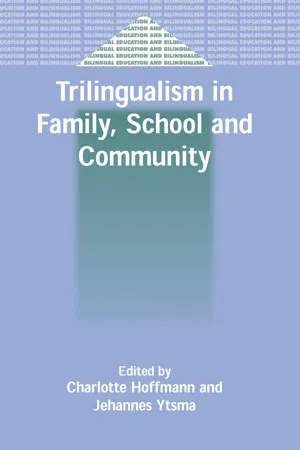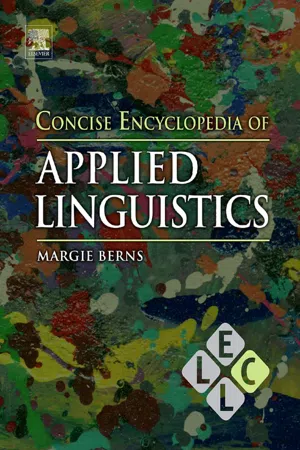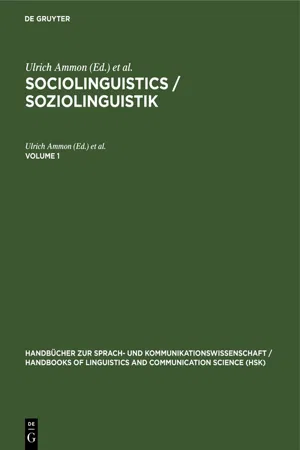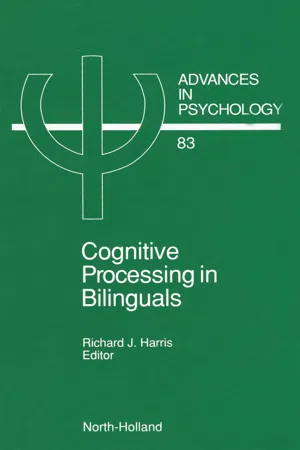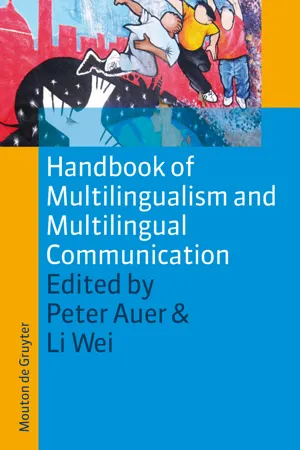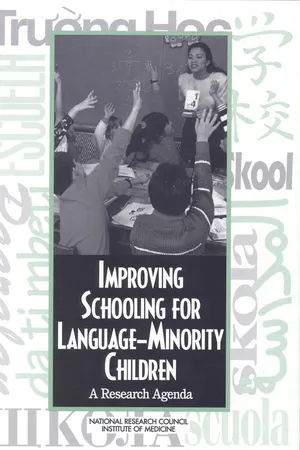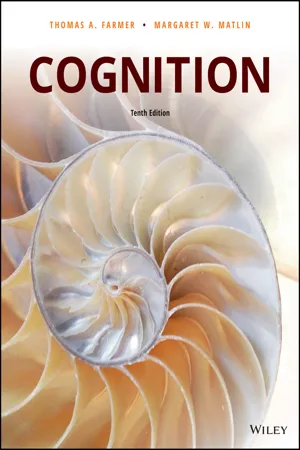Languages & Linguistics
Bilingualism
Bilingualism refers to the ability to speak and understand two languages proficiently. It encompasses various levels of language proficiency and can be acquired through different means, such as simultaneous exposure to two languages from birth or through formal education. Bilingualism can have cognitive, social, and economic benefits, and it is a common phenomenon in many parts of the world.
Written by Perlego with AI-assistance
Related key terms
1 of 5
12 Key excerpts on "Bilingualism"
- eBook - PDF
Two-Way Immersion in Biel/Bienne, Switzerland: Multilingual Education in the Public Primary School Filière Bilingue (FiBi)
A Longitudinal Study of Oral Proficiency Development of K-4 Learners in Their Languages of Schooling (French and (Swiss) German)
- Melanie Buser(Author)
- 2020(Publication Date)
- Peter Lang Group(Publisher)
One of the most comprehensive definitions of Bilingualism and its con- tributing factors to date is that used by Grosjean in his book “Parler plusieurs langues – Le monde des bilingues” (2015). He provides an overview of several defintions of Bilingualism by various authors, including the one he uses him- self throughout his book. Following the definition suggested by Grosjean, in this study the notion of Bilingualism is referred to as the “use of two or more languages or dialects on a regular basis in everyday life” (Grosjean, 2015: 16). Research on Bilingualism addresses topics such as the psycholinguistic functioning of the mind when using two codes, the early acquisition of two languages (of schooling and/or others), or the cognitive outcomes of being bilingual (Bialystok, 2001; Dewaele, 2003). With regard to educational contexts, a recurrent topic in this research field is the provision and evaluation of bilingual education as well as language policy issues in society (Baker, 2011; García, 2009a). Another common research topic on bilinguals is their mixing of elements from different languages. These code-switching processes of bilingual speakers, that is, when they use two languages simultaneously in social interaction, can be better represented as different positions along a continuum than as separate processes (Causa, 2002; Li Wei, 2008; García, 2009a; Blackledge and Creese, 2010; Paradis et al., 2011). Perspectives on Various Models of Bilingualism 54 Recently, García has offered a fresh perspective on Bilingualism by suggesting the term dynamic Bilingualism, a notion that is used in a very similar way to the commonly used term plurilingualism by the Council of Europe (Moore and Castellotti, 2008; Castellotti and Moore, 2011). - eBook - PDF
Language in Education
Social Implications
- Rita Elaine Silver, Soe Marlar Lwin(Authors)
- 2013(Publication Date)
- Bloomsbury Academic(Publisher)
8 How Do People Use Different Languages Differently? Manka M. Varghese and Rukmini Becerra Lubies INTRODUCTION In this chapter, we address the concept of Bilingualism. Bilingualism in its simplest definition refers to the ability to use at least two languages, varieties or codes. The ability to use multiple languages can refer to children and adults who are already using both languages or are learning additional languages. Moreover, these languages can be learned and adopted by users of the majority language or users of a minority language . The reason we are choosing the word use rather than speak is that bilinguals can use one or more of the different skills of speaking, listening, reading and writing, as well as vary in their proficiency in these skills. Along with understanding that bilinguals’ proficiency in and their usage of two languages is complex, it is also important to view bilinguals as involved in a holistic process of Bilingualism, not solely negotiating two monolingual codes, as we will discuss. For many bilinguals or emergent bilinguals, they have not necessarily had the same types of exposure in the two languages, or they might prefer using these two languages for different reasons and with different interlocutors and in different settings. For bilinguals, these two LANGUAGE IN EDUCATION 144 languages are viewed as interacting cognitively and often socially rather than acting in isolation to each other; in other words, one language will influence the other in various ways. We view Bilingualism as an asset and, in the same vein as García (2009), advocate Bilingualism as a way of promoting equity as well as strength in communities of majority and minority speakers. In this chapter, we underscore the social definition of Bilingualism and the fact that it cannot be separated from its speakers and the contexts in which it is used. We start by reviewing the main definitions of a bilingual individual and the routes people follow to become bilingual. - Charlotte Hoffmann, Jehannes Ytsma(Authors)
- 2003(Publication Date)
- Multilingual Matters(Publisher)
Earlier and more recent studies in multilingual-ism endeavor to develop theoretical concepts to explain multilingual processes (Cenoz, 2000; Cenoz & Genesee, 1998; Cenoz & Jessner, 2000; Cenoz & Valencia, 1994; Grosjean, 1985; Ringbom, 1987; Swain et al ., 1990). Bilingualism/bilinguality dichotomy As early as 1981 , Hamers differentiated between Bilingualism and bilinguality. Bilinguality was posited as the psychological state of an individual who has access to more than one linguistic code as a means of social communication; the degree of access will vary along a number of dimensions which are psychological, cognitive, psycholinguistic, social psychological, sociological, sociolinguistic, sociocultural and linguistic (Hamers, 1981). The concept of Bilingualism, on the other hand, includes that of bilinguality (or individual Bilingualism), but refers equally to the state of a linguistic community in which two languages are in contact, with the result that two codes can be used in the same interaction and that a number of individuals are bilingual (societal Bilingualism). As with other conceptualizations of ‘lingualism’ and ‘glossia’, societal 1111 2 3 4 5 6 7 8 9 1011 1 2 3111 4 5 6 7 8 9 20111 1 2 3 4 5 6 7 8 9 30111 1 2 3 4 5 6 7 8 9 40 41111 Multilingualism in Cultural Contexts 15 15 Bilingualism is premised on the existence of a relatively fixed intranational set of macro-ecologies . Hoffmann also points to the changes brought about here by the effects of immigration and in-migration societies. She writes: Nevertheless, a move from the macro-level of analysis of the societal presence of English in European countries to a micro-analysis of its presence shows that beyond these ecologies it is the single speaker, with his or her potential for using English societally with other single speakers in multifarious emerging and shifting micro-contexts, who forms the locus for the popular use and spread of English as a lingua franca today.- eBook - ePub
Introducing Second Language Acquisition
Perspectives and Practices
- Kirsten M. Hummel(Author)
- 2013(Publication Date)
- Wiley-Blackwell(Publisher)
www.the-fools-journey.blogspot.com .There have been a number of perspectives on Bilingualism over the years, and, as a consequence, differences in how to define “a bilingual.” Leonard Bloomfield, a renowned American structuralist linguist working in the early part of the last century, considered a bilingual to be someone with “native-like control of two languages” (1933, p. 56). In a similar vein, the Swedish linguist, Bertil Malmberg (1977, pp. 134–135), described a bilingual in the following way:A bilingual is an individual who, in addition to his mother tongue, has acquired from childhood onwards or from an early age a second language by natural means (in principle not by formal instruction), so that he has become a fully competent member of the other linguistic community within the sphere, the occupational or social group, to which he naturally belongs.According to the definitions offered by Bloomfield and Malmberg, both Alberto and Walid are indeed bilinguals. On the other hand, other specialists are not quite so categorical in requiring full and “native-like control” in order for one to qualify as “bilingual.” For instance, for the sociolinguist Einar Haugen (1953, p. 7) Bilingualism is: “the point where a speaker can first produce complete meaningful utterances in the other language.” For the Canadian sociolinguist William Mackey (1962, p. 52), Bilingualism is: “the alternate use of two or more languages by the same individual.” He specified (1956, p. 8): “Bilingualism is entirely relative, the point at which a speaker of a second language becomes bilingual is either arbitrary or impossible to determine.” Uriel Weinreich (1953) defined Bilingualism as “the practice of alternately using two languages.” In more recent times, the sociolinguist Li Wei (2007, p. 7) described a bilingual as: “someone with the possession of two languages.” According to the definitions proposed by Haugan, Mackey, Weinreich, and Wei, in addition to Alberto and Walid, we can consider Mila, as well as the other L2 learners who have guided our discussions throughout this book, Steve, Linda, and Xia Mei, as bilinguals. We see then that the person who is considered to be bilingual varies considerably according to the way in which this term is defined. - eBook - PDF
- Margie Berns(Author)
- 2010(Publication Date)
- Elsevier(Publisher)
If the second language is acquired in a natural setting before the age of five that individual is termed an early bilingual, in contrast with a late bilingual who learns his second language after the age of five either in home or in schools. Labels such as fluent vs. non-fluent, functional vs. non-functional, balanced vs. unbalanced, primary vs. secondary, and partial vs. complete refer, either to a varying command in different types of language proficiency (e.g., spoken, listening, writing, etc.), or an asymmetrical relation-ship (dominance) between two languages. A com-pound vs. coordinate bilingual refers to the way two languages are processed in the brain. The list is by no means exhaustive. Other major distinctions such as simultaneous vs. sequential are discussed in the next section. Similarly, Bilingualism can be viewed from individual, societal (attitudes towards bilingual-ism), and political (i.e., government policies toward Bilingualism) perspectives. In general, a bilingual person demonstrates many complex attributes rarely seen in a monolingual per-son. For that reason, a bilingual is not equivalent to two monolinguals, but something entirely different. This working definition of Bilingualism is offered by Bloomfield (1933), who claimed that a bilingual is one who has a native-like control of two languages, i.e., a balanced bilingual (see Grosjean 1982 or Edwards, 2004 for more details). Patterns and Mechanisms in Bilinglual Language Development Providing either a natural environment or inputs in monolingual/dominant language speech communities is not a challenging task. The same is also true for those societies where social and political systems are conducive to Bilingualism. For instance, in India, where Bilingualism is viewed as natural, approved by society, and further nurtured by government lan-guage policies, linguistic groups and communities do not need to take any special measures to assure that their children receive input from two languages. - eBook - PDF
- Ulrich Ammon, Norbert Dittmar, Klaus J. Mattheier, Peter Trudgill, Ulrich Ammon, Norbert Dittmar, Klaus J. Mattheier, Peter Trudgill(Authors)
- 2020(Publication Date)
- De Gruyter Mouton(Publisher)
82. Bilingualism and Multilingualism 699 maine, S., ed., Socioiinguistic variation in speech communities, London, 125 — 140. Scherer, Klaus R. (1979) Voice and speech correla-tes of perceived social influence in simulated ju-ries, in: Giles, H./St Clair, R., eds., Language and social psychology, Baltimore, 88 — 120. Scotton, Carol M. (1976) Strategies of neutrality: language choice in uncertain situations, in: Lan-guage 52, 9 1 9 -9 4 1 . Shaw, M. E. (1964) Communication networks, in: Advances in Experimental Social Psychology, 111-147. Tucker, G. Richard/Lambert, Wallace E. (1969) White and Negro listeners' reactions to various American-English dialects, in: Social Forces 47, 4 6 3 -4 6 8 . Dennis R. Preston, Ann Arbor, Michigan (USA) 82. Bilingualism and Multilingualism 1. Scope 2. Terms and Definitions 3. Causes 4. Incidence 5. Types 6. Consequences of Bilingualism 7. Literature (selected) 1. Scope Any explanation of the phenomenon of mul-tilingualism involves descriptions of the many functions and levels of each of the languages in contact. Since the number of languages is theoretically indeterminate, it is impossible to treat of the dimensions of all combinations of these languages. What is said about the use of two languages, however, can be applied by extension to the use of three, four or more. The variables of Bilingualism are therefore equally applicable to descriptions of trilingu-alism, quadrilingualism and, more generally, to the phenomenon of multilingualism. These are simply numerical extensions of the same variables. That is why Weinreich (1953) and Haugen (1973), and later students of the phe-nomenon, have found it convenient to sub-sume multilingualism under the more general heading of Bilingualism, a practice which will be adopted in what follows. 2. Terms and Definitions There are several words for the knowledge and use of two or more languages and there are different terms to indicate situations which are in fact the same. - eBook - PDF
Three is a Crowd?
Acquiring Portuguese in a Trilingual Environment
- Madalena Cruz-Ferreira(Author)
- 2006(Publication Date)
- Multilingual Matters(Publisher)
One added complication to the controversy surrounding the definition of bilingual-ism is that there seems to be a reluctance to accept a bilingual as a native speaker of two languages. The implicit assumption seems to be that bilinguals are one thing, native speakers are another. Both definitions besides stumble on the problem of how to quantify the degree of fluency in each language, in order to draw comparisons between their use. In addition, the term bilingual (along with its cognates) is used to label both individual speakers and countries, individuals or groups of people that acquire several languages from birth, as well as those who learn a new language through schooling, or through settling in a different country (see Fishman (2000) for discussion of different scopes of this term). 13 Clearly, each one of these is a different ‘bilingual’, although findings about each bilingual type tend to be generalised to bilinguals as a whole, by virtue of the use of a single label to identify them all. Bilingualism versus dual monolingualism One way of starting discussion on this issue is perhaps to clarify what Bilingualism is not, according to the consensus in the literature. A bilingual is not the sum of two monolinguals, hence Bilingualism does not consist in a cumulative repertoire of different languages. If taken seriously, this insight means two things: one, that Bilingualism and monolingualism are two distinct uses of language each in its own right, and two, that monolingual uses of language cannot be compared to bilingual uses of language, nor vice versa . Nevertheless, a large proportion of research on Bilingualism appears to pay simple lip-service to the lack of a clear-cut basis for comparison, and proceeds to compare bilingual and monolingual populations, experimental or otherwise, by eliciting or gleaning features said to characterise the linguistic proficiencies of one group as opposed to the other, in the same language(s). - eBook - PDF
Power, Prestige and Bilingualism
International Perspectives on Elite Bilingual Education
- Anne-Marie de Mejía, Dr. Anne-Marie de Mejía(Authors)
- 2002(Publication Date)
- Multilingual Matters(Publisher)
Chapter 2 Definitions and Distinctions Introduction Any attempt to provide ‘hard and fast’ definitions of concepts such as bilin-gualism and bilingual education seems doomed to failure, especially if we take into account the fact that this field is highly interdisciplinary, a fact recognised by Joshua Fishman in 1976 when he wrote, ‘Bilingual education itself is not a discipline, it is an interdisciplinary activity’ (Fishman, 1976: 124). Thus, we have researchers such as Heller (1994, 1999) who see Bilingualism and bilingual education in relation to polit-ical issues; scholars such as Coulmas (1992) and García (1995) who are interested in the economic aspects of Bilingualism; linguists like Poplack (1980) who concentrate their attention on linguistic aspects of bilingual speech; sociolinguists like Fishman (1972, 1976, 1980, 1991) and Hornberger, (1989, 1991) who are concerned to relate bilingual phenomena to their context of situation; psycholinguists such as Grosjean (1982, 1985) and Cummins (1981, 1986, 2000) who are interested in how bilinguals acquire and process their languages; neurolinguists like Fabbro (1999), Paradis (2000) and Vraid (2001), part of a growing group of neurolingists who have shown interest in Bilingualism; those who take a historical perspective on the development of Bilingualism and bilingual education, such as Lewis (1977, 1981); and education-alists like Swain and Lapkin (1982, 1986), Ovando and Collier (1986, 1998) and Baker (2001) who investigate how children and adults become bilingual in educational institutions. It is therefore no surprise that terms such as ‘second language’, ‘bilin-gual proficiency’ and ‘identity’ take on different connotations according to which tradition the particular researcher or author comes from. As well as the interdisciplinary nature of the field itself, we must also bear in mind that there are individual researchers who try to incorporate an interdisci-plinary dimension within their work. - eBook - PDF
- R.J. Harris(Author)
- 1992(Publication Date)
- North Holland(Publisher)
In this chapter, the term rrunslation is used to refer to all modes of reformulating a message from one language (the Source Language) into a message in another language (the Target Language). That is, the term frunslution is used regardless o f whether the Source or Target Language message is oral or written; for example, oral to written and written to oral would both be considered translation. This is different than the case in the literature on professional translation, which makes the distinction between translation and interpretation, where translation refers to the written modality and interpretation to the oral modality. The term Bilingualism also requires a working definition. Bilingunlisrn has become a social term to cover populations with different proficiencies and linguistic backgrounds, from monolinguals beginning a second language to persons fluent in two languages. In this chapter, bilingual is used to mean a person who is able to produce a complete meaningful utterance in two languages (Haugen, 1956: 6). Bilingualism does not imply equal mastery of two languages, but rather the ability to use two languages; hence it is best described in terms of degree of bilingual fluency (DeAvila & Duncan, 1980). Of particular interest to researchers has been the effect of Bilingualism on cognitive development. Many early researchers concluded that Bilingualism had a negative impact on development (e.g., Anastasi & Cordova, 1953; Saer, 1924; F. Smith, 1923; M. Smith, 1939). Bilingualism was thought to cause children to become mentally confused--at best, to be a mental burden for developing children. However, as early as 1928, there already existed a debate over the validity of these negative conclusions, and the counterargument had been presented that Bilingualism, in fact, develops intellectual abilities through the comparison and differentiation of two language systems (Braunhausen, 1928). - Peter Auer, Li Wei, Peter Auer, Li Wei(Authors)
- 2008(Publication Date)
- De Gruyter Mouton(Publisher)
There is equal uncertainty about the number of languages a bi- and multilingual actually knows. Etymologically bilingual means a person knowing two languages. It has been used indiscriminately how-ever to refer to any individual knowing more than one language. The argument is that any language acquired after the first one can be labeled L2, and that one can possess several L2s (Cook 2002, 2003). The implication of such a decision is that these ‘foreign’ languages may have been acquired at different times in the individual’s life, up to varying degrees of proficiency, but that the numbering of these languages is not really important. Such a perspective is typical for re-searchers who worked on bilinguals (L1+L2), or on monolinguals in the process of acquiring a second language. There was no need for these researchers to use a more fine-grained distinction between the first L2 and any language acquired subsequently. Their research designs typically had two categories: a monolin-gual control group and the experimental group with bilinguals or second language learners (cf. Bialystok 2002). Whether these bilinguals were in fact trilinguals, quadrilinguals or pentalinguals did not matter to them. These researchers constitute the majority in the field of applied linguistics. A need for finer distinctions and categorizations emerged with the onset of trilingualism re-search (Cenoz and Jessner 2000; Cenoz et al. 2001; De Angelis 2005a, b). Tri-lingualism researchers set out to investigate whether trilinguals differed from bilinguals. The research thus far does seem to confirm the seminal work of Voor-winde who concluded that “phenomena related to trilingualism (are) more com-plex than, rather than basically different from, those related to Bilingualism” (Voorwinde 1981: 25). Differences between Bilingualism and trilingualism are mainly of a quantitative nature as the same processing mechanisms operate (Hoffmann 2001).- (Author)
- 0(Publication Date)
- The National Academies Press(Publisher)
Expansion of this system to include data on second- language acquisition and bilingual children would greatly increase the vitality and productivity of the field. 2-4. It is essential to understand the interaction between language and other domains of human functioning. Research reviewed here on the consequences of Bilingualism has concluded that there are no negative consequences of learning two languages in childhood and that there are some positive correlations between Bilingualism and general cognitive ability. This research should move beyond seeking macro-level effects and begin looking for more detailed and specific relationships between linguistic representations on the one hand and cognitive and social representations on the Improving Schooling for Language-Minority Children: A Research Agenda Copyright National Academy of Sciences. All rights reserved. Bilingualism AND SECOND-LANGUAGE LEARNING 45 other. This recommendation is revisited in the discussion of content area learning and the recommendations in Chapter 3. 2-5. Macro-level questions about language shift in the United States have amply demonstrated the short-lived nature of non-English languages. Re- search is needed to help in understanding the dynamics of language shift. Such research would include examining how messages concerning the value of native languages are conveyed, how children and youth understand such mes- sages, what the effects are on the children’s identities and their school achieve- ment, and what the likelihood is of maintaining the native language while learn- ing English. We need also to develop a more specific understanding of what is meant by language attrition, such as the relationship between language choice (choosing not to use one’s native language) and the loss of language proficiency.- eBook - PDF
- Thomas A. Farmer, Margaret W. Matlin(Authors)
- 2019(Publication Date)
- Wiley(Publisher)
A student might say, “This sentence just doesn’t sound right,” whereas an expert might say, “The subject and the verb don’t agree here.” One final caution about the revision process focuses on the proofreading stage. Daneman and Stainton (1993) confirmed what many people already suspected: You can proofread someone else’s writing more accurately than your own. When you are very familiar with a paper that you’ve just written, you often overlook the errors in the text. Top-down processing (Theme 5) triumphs again! Bilingualism Between 6,000 and 7,000 languages exist in the world (Lupyan & Dale, 2010; Segalowitz, 2010), and many people throughout the world can speak at least two of those languages (Schwartz & Kroll, 2006). In fact, knowing multiple languages is more typical than knowing only one. A bilingual speaker is someone who is fluent in two different languages (Harley, 2008; Schwartz & Kroll, 2006). The related term multilingual speaker refers to someone who speaks more than two languages. Some bilinguals learn two languages simultaneously during childhood, an arrangement called simul- taneous Bilingualism. Other bilinguals experience sequential Bilingualism; their native language is referred to as their first language, and the nonnative language that they acquire is their second language (De Groot, 2011). LANGUAGE II: LANGUAGE PRODUCTION AND Bilingualism 228 In this section on Bilingualism, we first discuss some background information, as well as the social context of Bilingualism. Then, we note some advantages that people experience as a result of being bilingual. Background on Bilingualism More than half of the people in the world are at least somewhat bilingual (Luna, 2011; Schwartz & Kroll, 2006). Some people live in countries where at least two languages are commonly used. These countries include Canada, Belgium, Spain, and Switzerland. Other people become bilingual because their home language is different from the language used for school and business.
Index pages curate the most relevant extracts from our library of academic textbooks. They’ve been created using an in-house natural language model (NLM), each adding context and meaning to key research topics.
